|
[ Section Lepidella page. ]
[ Amanita Studies home. ]
[ Keys & Checklist/Picturebooks ] "Gray Rags Lepidella"
Technical description (t.b.d.) BRIEF DESCRIPTION: Amanita cinereopannosa has a white or whitish pileus (sometimes with a silvery sheen), is 70 - 150 mm wide with an appendiculate margin (not always so dramatic as in the accompanying photo), is not striate at the margin, and is decorated over the center part by brownish gray subpyramidal warts that, under a hand lens, appear to be like mudpies with the fingerprints of children on them (photo, below left). The remnants are more flat and patch-like closer to the margin.
The gills are free, crowded, more cream-colored (in side view) than the pileus. The short gills are subtruncate to attenuate. When fresh, the odor is of fresh dough; sometimes the odor becomes more like "chlorine" in age. The spores measure (8.0-) 8.8 - 12.0 (-14.1) × (4.9-) 5.2 - 7.0 (-8.3) µm and are ellipsoid to elongate (very infrequently cylindric) and amyloid. Clamps are not present at the bases of basidia. Amanita cinereopannosa has a range extending through the eastern U.S. from New England down through the Appalachian Mountains at least as far as the Carolinas. It occurs in mixed forests including oak (Quercus) in the northeastern U.S.A. Bas placed the present species in his stirps Strobiliformis (see A. strobiliformis (Paul. ex Vitt.) Bertillon in Dechambre. As far as field identification goes, the reader should review and compare A. cinereoconia G. F. Atk., A. onusta (Howe) Sacc., and A. tephrea Bas nom. prov. -- R. E. Tulloss Photos: ; R. E. Tulloss (top left, West Virginia; others in body of text, Vermont); L. R. Hesler (middle line, Tennessee, with permission of Dr. R. H. Petersen, Curator, L. R. Hesler Herbarium, Univ. of Tenn., Knoxville); Dr. Clark L. Ovrebo (top right and bottom line,GSMNP, North Carolina).
[ Section Lepidella page. ]
[ Amanita Studies home. ]
[ Keys & Checklist/Picturebooks ] Last changed 1 April 2009. |
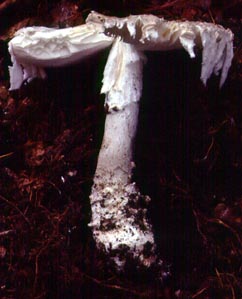
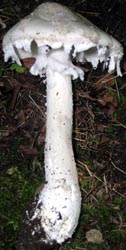
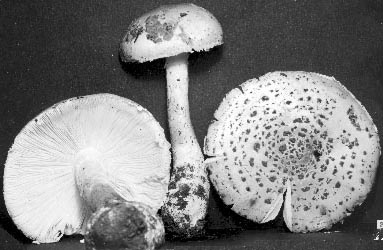
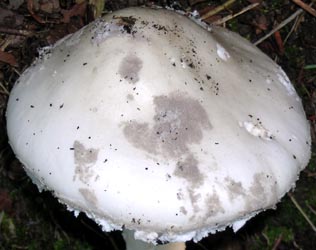
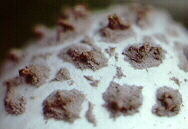 The stipe is 100 - 160 x 15 - 20 mm, has an apical, white, easily broken
annulus that is striate on the upper surface and sticks
to fingers easily. At the stipe base is a radicating bulb
The stipe is 100 - 160 x 15 - 20 mm, has an apical, white, easily broken
annulus that is striate on the upper surface and sticks
to fingers easily. At the stipe base is a radicating bulb up to 65 x 35 mm. At the top of the bulb, there are sometimes several rows
of rectangular scales (see photo, lower right). The bulb
may have volval warts distributed over it that are
similar to the warts on the pileus; or volval warts may
be absent from the bulb.
up to 65 x 35 mm. At the top of the bulb, there are sometimes several rows
of rectangular scales (see photo, lower right). The bulb
may have volval warts distributed over it that are
similar to the warts on the pileus; or volval warts may
be absent from the bulb.